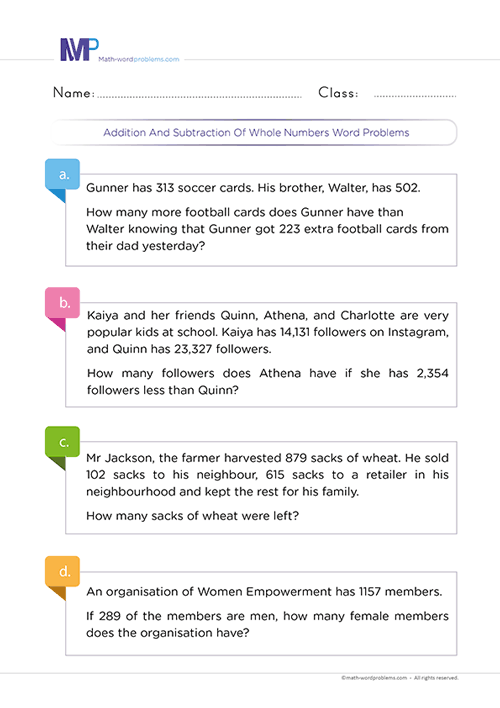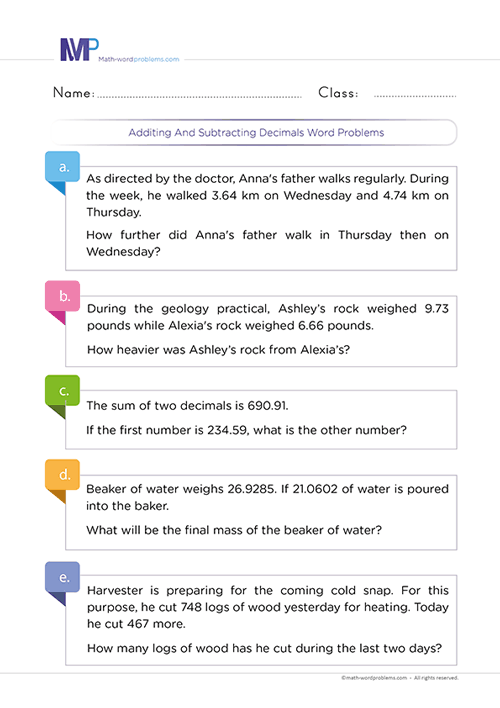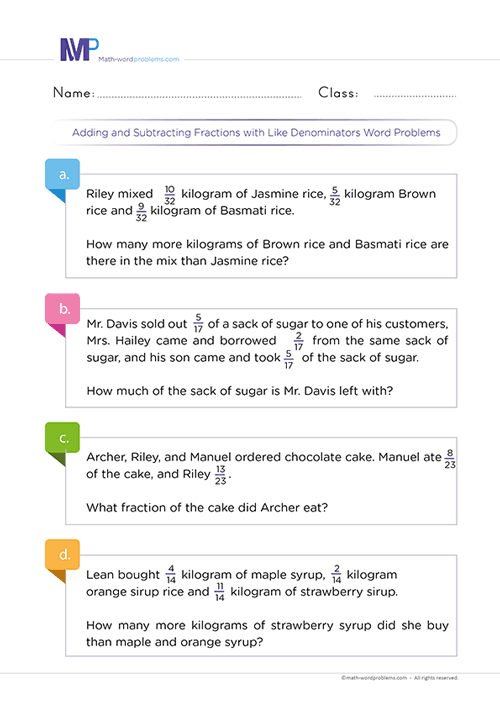 How to solve addition and subtraction of whole numbers word problems
How to solve addition and subtraction of whole numbers word problems
Are you wondering how to solve addition and subtraction of whole numbers word problems the easiest way? Then, you are at the right place. Here, you will enjoy our step-by-step procedure to uplift your kids’ minds on effortlessly adding and subtracting whole numbers word problems.
The effectiveness of this process will enable kids to engage in higher-order thinking necessary to enhance word problem-solving skills.
Steps on how to solve addition and subtraction of whole numbers word problems
Here are simple steps on how to solve addition and subtraction of whole numbers word problems. One thing that usually confuses 5th graders is when the question does not present itself in a straightforward mathematical equation.
So, we have formulated a powerful step-by-step guide to pave the way and make your kids successful and exceptional math word problem solvers. Henceforth, their general solving skills of math word problems will improve significantly.
However, we will attach some extraordinary real-life examples so you can see how incredible these steps work.
Step 1: IDENTIFY:
To identify the problem, begin by finding out the scenario the problem wants you to solve. For instance, whether to add or subtract. You can do this by figuring out the most important keywords in the word problem. Like:
- If it is an addition word problem, you’ll find keywords like add, plus, more, total, increase, together/altogether, combined, sum, grow, join, both, etc.
- But when talking about subtraction word problems, some of the keywords you’ll come across include:- less, minus, take away, left, decrease, difference, remain, change, how many more, subtract, fewer, deduct, etc.
- ***One key Element for learners to understand is that they should not always rely on keywords alone. That is to say; the same keyword can have different meanings in different word problems.
- For this reason, we reiterate on the importance of reading the question very carefully to understand the situation that the word problem is describing, then figure out exactly which operation to use***
Step 2: STRATEGIZE OR GATHER RELEVANT INFORMATION:
How will you solve or tackle the problem?
One key thing you should remember is that each word problem may require a different format. Hence, the key points below will enable young math learners to tackle any format however it comes.
- Now, from the keyword(s) in the word problem, you will know if you need to add, subtract, or perform any other operation.
- However, know that you must not rely merely on keywords. Instead, try to understand the situation that the problem is describing.
- Then, after knowing which operation you will perform, construct short expressions/sentences to represent the given word problem. This visual representation of the most vital information makes it easier to solve the word problem.
Step 3: CREATE THE EQUATION:
Here, you’ll write down a numerical equation representing the information in the word problem.
Step 4: PROVIDE A SOLUTION:
Now, after writing down the math problem (numerical equation), you can go ahead and solve the problem. Another essential thing to constantly recall is the unit of measurement if any.
Step 5: CHECK YOUR WORK:
Finally, check if your answer makes sense. For instance, estimate the answer and see if it is close to what you expected. However, if the answer is not what you expected, go back to step one and start all over again.
Examples on how to add and subtract whole numbers word problems
Example one: Here is a real-life example on how to solve addition word problems using the steps described above.
Step 1:The important numbers here are 210 and 305. The keyword(s) found in the word problem is “in all.”
Step 2:How will you solve the problem? You see that the keyword(s) “in all” found in the word problem calls for addition.
Now, we have to construct short sentences to represent the given word problem.
- Number of bags delivered to matter’s store = 210.
- Number of bags delivered to Mr. James’ store = 305.
- Therefore, the number of bags she has delivered in all = the number of bags delivered to matter’s store + the number of bags delivered to Mr. James’ store
Step 3:Next, write down a numerical equation to represent the bolded sentence in step 2 aboveto solve this word problem:
210 + 305 = ?
Step 4:Last but not least, stack the values, so their place values line up. Then, go ahead and add the values. Also, do not forget to add the unit of measurement to your final answer, if any.
So, she has delivered 515 bags in all.
Step 5: Finally, check if your answer makes sense. For example, estimate the answer and see if it is close to what you expected. However, if the answer is not what you expected, go back to step one and start all over again.
Example two: Below here is an enriching example of a subtraction word problem for grade 5.
Step 1: The important numbers here are 9,350 and 3,676. The keyword(s) found in the word problem is “how many.”
Step 2: How will you solve the problem? You see that the keyword(s) “how many” found in the word problem and that we already have two things joined together, another standing on its own, while we are required to look for another, calls for subtraction.
Now, we have to construct short sentences to represent the given word problem.
- Number of bouquets of flowers she delivered last year = 3,676.
- Number of bouquets of flowers she delivered last year and this year = 9,350.
- Therefore, the number of bouquets of flowers she delivered this year = the number of bouquets of flowers she delivered last year and this year - The number of bouquets she delivered last year.
Step 3: Next, write down a numerical equation to represent the bolded statement in step 2 above to solve this word problem:
9,350 – 3,676 = ?
Step 4: Last but not the least, stack the values so that their place values should line up, i.e., use the column method of addition to add the values. Also, do not forget to add the unit of measurement to your final result, if any.
So, she delivered 5,674 bouquets of flowers this year.
Step 5: Finally, check if your answer makes sense. i.e., estimate the answer and see if it is close to what you expected. However, if the answer is not what you expected, go back to step one and start all over again.






